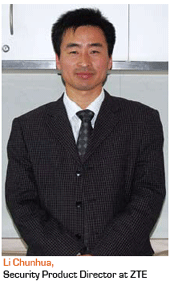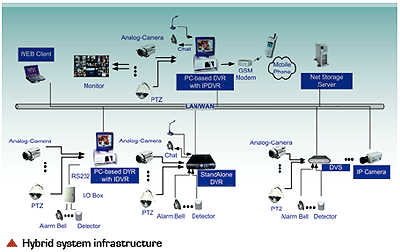The reliability of IP solutions is still open to question due to bandwidth limitations and unstable network environments. Network video management systems managing more than 10,000 surveillance sites and systems, however, have been widely implemented in China. The key element is cooperation among leading companies from telecommunications and software to hardware providers.
The reliability of IP solutions is still open to question due to bandwidth limitations and unstable network environments. Network video management systems managing more than 10,000 surveillance sites and systems, however, have been widely implemented in China. The key element is cooperation among leading companies from telecommunications and software to hardware providers.
While network cameras and NVR products were unveiled in China in 2005, early network environments suffered from flaws. To remedy this, partnerships between telecommunication providers and electronic security providers helped deliver complete network video management solutions. Telecommunicat ion providers like China Telecom partnered with Huxinhutong on video management platforms for various MegaEyes projects(name registered by Huxinhutong in 2001). This cooperation encouraged China Netcom to come out with a similar customized bandwidth service: CNC View. Both are meant to provide suitable networking environments for different security demands to manage the huge amount of video data streaming via network infrastructure from public security, enterprise surveillance and personal home security along with supporting 3G mobile image transmission.
MegaEyes and CNC View have further improved their services by dividing product offerings into equipment and system platforms for easy maintenance. All customers have to do is call China Telecom or China Netcom. MegaEyes and CNC View offer telecommunication-based, enterprise-based or home security-based systems. These two nationwide projects have garnered strong backup from device and system platform suppliers.
Major platform providers involved include Huxinhutong, Kedacom and ZTE. These are able to offer complex systems, technical support and hardware via partnerships with suppliers.
In the provinces, cooperation between manufacturers and local telecommunication companies is ongoing as well. Often, this is on Safe City projects, where video monitoring and site management are the main objectives. These system suppliers are often security product makers with excellent software R&D capabilities such as HuangHe, Launch and Skyvision.
Their software platforms focus on surveillance management, unlike MegaEyes or CNC View, which include more optional functions for telecommunication- based calculation of user fees or enterprise-based ones commercial information with images sent to users or notification via SMS.
Multiple System Management Platform
For large network video management platforms connecting numerous systems and sites, MegaEyes solutions and services cover banking, the environment, public security, schools, enterprises and telecom data management. Platforms are differentiated by core functions and customization. Huxinhutong the only platform provider that can use MegaEyes as its trading logohas been working on telecom management platform solutions since 2000; its complex platform is based on mature technology, while customization can be implemented in a short time.
ZTE has multi-service management software to switch platforms and functions. If, for example, the platform is meant to be installed for equipment room surveillance, the unit would include functions to report working device status as well as alarm triggering protection and notification. For customs, the management platform might include mobile surveillance of freight.
"Video Digital technology's true value to security is realized when it is seamlessly integrated into a total security knowledge management solution," said Zhou Shengqiang, Security Product Director at Kedacom. "With seamless integration, there is a single system based on scalable distributed architecture, in which various components can be seamlessly plugged through well-defined open interfaces, behaving as an integral part of this system."
To provide a system that integrates access control, video surveillance and environment monitoring, the system must be open and standard-based to connect with all card readers, cameras, sensors and management consoles. In addition, system architecture should be IP-based to distribute applications and intelligence at the edge of the network, while connecting to backend management consoles. Ideally, it should integrate security, building automation and IT operations as well.
In order to achieve the goal of open architecture, Huxinhutong and Kedacom are working continuously on MegaEyes standards with China Telecom, said Li Yang, General Manager of Huxinhutong. The third version of the standards will enhance development of network video management systems since large applications have strict demands for functionality, stability and compatibility. The guidelines indicate all regulations and specifications of hardware devices connecting to major platforms.
Huxinghutong has also worked with many IT companies like IBM, Nokia and Siemens to make its management systems more compatible and powerful in both hardware and software environments. In 2006, IBM upgraded cooperation with Huxinhutong, providing its powerful BladeCenter HS21 server for MegaEyes.

"For public security or enterprise applications, information is stored in multiple level databases," said Li Chunhua, Security Product Director at ZTE. "Such systems are meant to grant access to information as determined by security administrators to reduce the risk of major system breakdown when one centralized system processes huge data streams at the same time."
Large video management platforms feature powerful transmission with multiple methods (IP, E1, HDSL, CDMA/GPRS, BWA, microwave and 3G) as well as flexible networking methods(P2P and P2MP ) , high-resolution image quality, and easy image switching and display. The platform supports device management functions such as light control, GIS and camera control.
Customers can even rent devices, including IP cameras, storage servers and system platforms; after-sales maintenance is taken care of by telecommunication companies. Mirroring backup is supported in case of router failure. For data security, the platforms feature user log-in protection, USB key lock and MAC lock protection to ensure accessibility at different levels.
Solution providers are also working on different functions for customized applications, combining video data with commercial benefits. Kedacom, for example, stresses customization for educational fields. Established in 1995, Kedacom established its Shanghai R&D center in 2001 to develop video and network communication technologies. It has 31 branches domestically, and one in Singapore.
In 2005, Kedacom was listed on the Singapore stock exchange. Given that its core software has complete functions, it regards customization as simply adding value. The BB online, for example, is a network video management system for kindergartens and parents. The kinder-gartens install cameras (usually 15 to 20 in each school) and network video decoders with VDSL or LAN network environments.
Telecommunication companies support servers and Internet platforms so parents can log onto the video Web page. Kueyan Telecom has deployed the program so parents get real-time images of kids at kindergartens. BB online software connects to the MegaEyes digital surveillance system. The system makes it very practical for teachers to share different teaching methods; it has a database for lessons, food and daily activities. BB online uses fiberoptic transmission and ADSL so hundreds of parents can visit the system at the same time. Value-added functions include video playback of school life, important notifications, forums and instant feedback via SMS or Internet between parents and teachers.
Meanwhile, ZTE specializes in power plant and unmanned site surveillance and management. It manufactures cameras, DVRs and DVSs. The ZTE platform delivers advantages in terms of scalability, security and reliability. The management platform checks working device and user status as well.
Its ViewEye central multimedia surveillance system can be applied to multiple scenarios in the electric power industry from visual dispatch of electric power to image monitoring of unmanned power transformation stations, buildings and equipment rooms. ViewEye also supports five remote functions, including live view, measuring, signaling, control and configuration to reduce management cost.
Security Management Platforms

For small and medium-sized network video management systems implemented in retail stores, supermarkets, enterprises, government and financial associations, customers work with DVR, DVS and IP camera manufacturers since hardware performance depends greatly on good management software.
DVR manufacturers with compatible central management systems (CMS) are able to ensure network video management functionality in small applications. Typically, the self-compatible platform has a client workstation with a user interface to control recording and playback as well as search capabilities and video display in multiple windows similar to a security video matrix view.
These solutions are practical when the primary concern is video backup and other information is secondarythose that require application-friendly functionality, such as ATMs for card number insertion onto video or POS systems for purchase information. Here, control and command of other systems is not the major target.
Suppliers are also launching PC-based NVRs to manage video data from various devices. "Different DVR or IP camera compression algorithms have compatibility problems," said Shu Yubo, Sales Director at Skyvision. "Chinese software platforms support most major brands like Hikvision, Dahua and Dali. Skyvision's NVR provides a platform that is compatible with those brands, and we are working on compatibility for international brands like Axis."
Established in 2003, Skyvision specializes in video coding and decoding, mode identification, IP network video transmission, stream media storage and indexing, software engineering, code reconstruction, AOP, J2EE, SOA, and large customized projects. Its network video management system uses the latest IT technology (J2EE) and supports all OS platform (Windows, Linux, Unix), B/S and C/S modes.
It is a flexible IP surveillance system that enables management of all net video devices (PC-based DVRs, video severs, embedded DVRs and access control) to support streaming media and alarm servers. It manages all cameras by groups with powerful e-maps. The system uploads alarm info onto the NVR system automatically with remote recording and configuration capabilities that support remote decoding of digital video and output to the monitor. IE plug and IE SDK are also provided.
Skyvision's NVR is fully digital networking architecture that provides a security and surveillance management platform for integrating CCTV systems, alarms, sensors and other surveillance devices. It supports video monitoring and recording, event management, video playback and event search. It adopts cascaded management technology and modular architecture for seamless security management and operation.
For users looking for management software to support IP cameras, HuangHe has NVR management software for a maximum of its 1,728 IP cameras. The system supports resolution up to D1, various recording modes, e-map, log lists and efficient event search. The system can be extended up to 10,000 sites.
Meanwhile Linovision's network video management system is an IP-based central management system that manages access of hundreds of cameras. It is the ideal solution for small and medium-sized surveillance applications. It features remote configuration, playback, recording of its branded IP cameras, IP modules, DVRs and DVSs as well as e-map, voice and server status check with multi-level user authentication and authorization.
Export Potential
HuangHe and Launch are quite active in overseas markets, selling mostly IP cameras and DVSs. Meanwhile, ZTE and Kedacom have standalone NVRs for video data delivery and management.
Furthermore, ZTE has more than 100 international offices and 52 R&D centers; its strong telecommunication background has given it a strong advantage in international markets. Localized and customized full-package services, including installation, have helped it promote its network video management system in South America and Africa.
Its ZXVM4100 series multimedia access unit is a standalone NVR device with Linux OS and MPEG-4 compression that is suitable for integrating local surveillance, video recording and network transmission. Video data is transferred via Internet to the ZXNVM C4100, which acts as a multimedia switch for TV wall displays or from relay servers to storage.
Kedacom's KDM8200E standalone NVR supports a maximum of 400 video channel inputs from LAN or WAN. The external IP storage device is optional. KDM8200E features high scalability with matrix infrastructure. Delivery of data streams is according to architecture, and it comes with both receiving and managing functionality.

Finally, Skyvisiona major software providerhas chosen to focus on security applications. According to Skyvision executives, the company's software productsmostly for NVR or hybrid solutionsare sold in more than 40 countries. These are primarily targeted at small and medium-sized applications that manage hundreds of video inputs. Its software is compatible with recommended hardware from Hikvision or Dahua. As a subsidiary of CSST, Skyvision's strategy is to promote its software with a full line of hardware products with support from all the other subsidiaries.
Even though analog systems dominate security applications, the benefits of pure IP solutions and products are gaining greater attention. Chinese suppliers see great potential as their products and solutions mature. When network environments are more affordable and stable, most expect that their IP products will be popular in overseas markets.